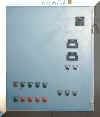

Sludge
/ Lime Mixer
In April of
1994 we were approached by Sunray Engineering of Weatherford, Texas about designing
and building machine industrial controls for a sludge / lime mixer. This machine design is used by city sewage plants to pasteurize
sewage sludge. The process works
by mixing a metered amount of sewage polymer with a metered amount of lime.
The chemical reaction of the two components creates heat.
The heat in turn pasteurizes the sewage to EPA standards and the city
is able to dispose of the product in land fills.
SCOPE: Our customer asked us to provide the machine industrial controls and Culver Welding, of Weatherford, Texas, to build and assemble the machines. Culver Welding also provides the maintenance support of the sludge mixers. In addition to working with Sunray Engineering I was to work closely with Culver Welding. Our customer wanted the machines to operate at various rates according to the output of the sewage plant. They also wanted to be able to adjust the percentage of lime that was mixed with the sewage polymer. Another feature that was required was to have an automatic feedback that would guarantee that the exact amount of ingredients would be mixed correctly.
RESULTS:
We chose to use Allen-Bradley Programmable Logic Controllers (PLC programming)
to control the sludge mixers. We have had experience with Allen-Bradley products and we know
their products to be reliable. They
also have a very good distribution system throughout the United States, thus
it is easy to get replacement parts if need be.
Magnetic pickups were used to determine both the sludge and lime screw
conveyor speeds. We used analog
signals from the PLC programming to control servo valves on the hydraulic power
unit to vary the speed of each screw conveyor.
The PLC programming also provided control for the various conveyors and
support equipment.
We tested the completed electrical cabinets at our shop using a machine simulator that we designed and built. The machine simulator allows us to test the wiring, sensors, and every aspect of the machine sequence and PLC programming at our shop before the industrial controls are installed in the field. This enables us to make corrections and changes before the machine design goes into service, thus saving valuable time and money. We delivered the cabinets, electrical wiring diagrams and complete documentation to Culver Welding. The documentation and wiring diagrams were complete enough that not a single telephone call was required during the installation of the cabinets and sensors or the initial startup of the sludge mixers.
In
total three mixers were built and installed.
They each have varying capacities.
Waxahachie, Texas
3.25
to 7.75 tons/hour
Birmingham, Alabama
30.0 to 58.0 tons/hour
Volutia Co., Florida
30.0 to 40.0 tons/hour
To our knowledge all three sludge mixers are still in service. Occasionally we are asked to make an upgrade or just go into the program and verify that the automatic feedback loop is still accurate. Below are pictures of Waxahatchie, Texas sludge mixer and control cabinet.
An added feature that we included on two of the sludge mixer systems was a modem communication module. This enabled us to monitor and edit the PLC programming from our office. We assembled a briefcase that included a modem, cellular telephone connection, all of the necessary cables and instructions. We provided the briefcase to Culver Welding. When they would travel to the various sludge mixers around the country they could provide me access to the PLC programming without us actually having to travel to plant. This feature has saved our customers many dollars in time and travel expenses. Below is a picture of the briefcase with components.
Home
| Site Map | Packager
| Sludge / Lime Mixer
| Bulk Cement Bin |
750-ton
Hydraulic Press | Resistance
Welder Tooling | Bender
Tooling
Multi-spindle Drill Press
Tooling | Contact Us